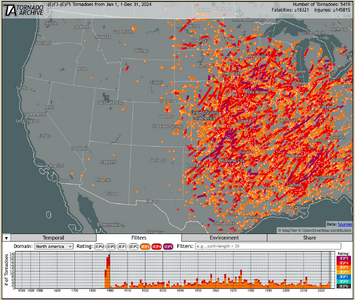Hannah.Taylor
EF4
The F-4 tornado that hit Yellowstone National Park on July 21, 1987 has my brian churning with questions.
The Yellowstone National Park F-4 Tornado
The park's lowest elevation is 5,282 ft (2 feet higher than Denver) and its highest point is 11,358 ft. At one point the tornado crossed the Continental Divide at over 10,000 ft as an F-4.
So, what is preventing a major EF-4 or EF-5 tornado from forming and striking the Denver Metro or Salt Lake City?
We almost had that precise scenario occur there on June 22, 2023 when a rather large tornado formed in Highlands Ranch, CO (SW side of the metro). None other than Reed Timmer was there to capture it.
Thankfully the damage was limited and the tornado was only on the ground for 6.3 miles and received an EF-1 rating from the NWS in Denver.
But what if it had stayed on the ground, ramped up and hit a lingering outflow boundary or hit a more unstable air mass? Is an EF-4 or EF-5 possible in the Denver metro?
I'm curious as to how it couldn't be possible considering a true F-4 hit Yellowstone NP and did F-4 damage at over 10,000 ft.
I should also say, I am in no way saying I would ever want this scenario to occur. My curiosity is just piqued from a scientific standpoint.
The Yellowstone National Park F-4 Tornado
The park's lowest elevation is 5,282 ft (2 feet higher than Denver) and its highest point is 11,358 ft. At one point the tornado crossed the Continental Divide at over 10,000 ft as an F-4.
So, what is preventing a major EF-4 or EF-5 tornado from forming and striking the Denver Metro or Salt Lake City?
We almost had that precise scenario occur there on June 22, 2023 when a rather large tornado formed in Highlands Ranch, CO (SW side of the metro). None other than Reed Timmer was there to capture it.
Thankfully the damage was limited and the tornado was only on the ground for 6.3 miles and received an EF-1 rating from the NWS in Denver.
But what if it had stayed on the ground, ramped up and hit a lingering outflow boundary or hit a more unstable air mass? Is an EF-4 or EF-5 possible in the Denver metro?
I'm curious as to how it couldn't be possible considering a true F-4 hit Yellowstone NP and did F-4 damage at over 10,000 ft.
I should also say, I am in no way saying I would ever want this scenario to occur. My curiosity is just piqued from a scientific standpoint.

